Capturing Be/longing: A Dialogue with Hong Kong’s Migrant Domestic Worker Photographers
by: Christine Vicera , June 25, 2022
by: Christine Vicera , June 25, 2022
This interview critically interrogates what Eve Tuck refers to as ‘damage-centred narratives’ of tragedy, sorrow, and loss that frame migrant domestic worker (MDW) communities in Hong Kong. (Tuck 2009) How does photography offer insight into their experiences of be/longing [1] (being, longing, and belonging)? How does the camera allow them to reclaim agency, honour the multiplicities inherent in their shifting identities as mobile subjects, and hence transform their stories into archives of resistance that refuse to be silenced by the coloniality of being, sensing, and knowing?
Narratives that frame MDWs as pawns in transnational capitalism and Hong Kong’s economy are ubiquitous in mainstream media. (Carvalho 2019; Lin Sihan 2021; Chu Man-kin 2021; Leung 2019 & Unknown 2019) This, together with the pervasive reporting on their experiences of having been subject to discrimination and violence—the highly publicised cases of Erwiana Sulistyaningsih whose employer subjected her to domestic abuse, and more recently the sexual abuse and harassment they faced throughout Hong Kong’s pandemic ‘lockdown’—are two examples among many others that affect how they are seen. (Siu 2018 & Cheng 2021) While this framing rhetoric centred on violence and loss has given MDW communities the opportunity to demand accountability from institutions that have failed them, these narratives are still damaging as they refuse to recognise MDWs as empowered agents in their own right.
Here, Christine Vicera, a Hong Kong-raised Filipino researcher, writer, and filmmaker speaks to three MDW photographers: Leeh Ann Hidalgo, Khristel Mae Dacanay Alterado, and Terenia Puspita. They reflect on how photography has become a means through which each of them navigate the contentious relationship between their identities as women, MDWs from the Philippines/Indonesia, and 香港人, Hong Kongers.
Khristel and Terenia’s work was featured in ‘We Create Home Kong’, an exhibition organised by Lensational [2], a non-profit social enterprise that gives underrepresented women access to cameras and media training.
*
Christine Vicera (CV): When did you start taking photos? Was there a specific moment in your life that made you want to pick up the camera?
Leeh Ann Hidalgo (LAH): I first got into photography when I was in the sixth grade. My aunt gifted me a camera. She loves taking photos. Since she’s based in the United Kingdom, and back then there was no video chat, she shared her life with us through photos.
I picked up photography again in 2014. I was in Macau at that time waiting for my new visa. That was also when I wanted to leave Hong Kong and go home. I was at a beach, and I saw a mother and her child. I didn’t have a camera, so I used my tablet to take photos of them. When I returned to my boarding house and revisited the photos, I realised that photography helped me divert the sadness and the homesickness that I felt in Hong Kong. It became therapy for me.
Later, it became a way through which I navigated my identity in Hong Kong, and [a way] to show everyone that I’m a Hong Konger too. I wanted to tell the story of migrant workers by capturing the locals to show that we are not different. What the locals do, we do.
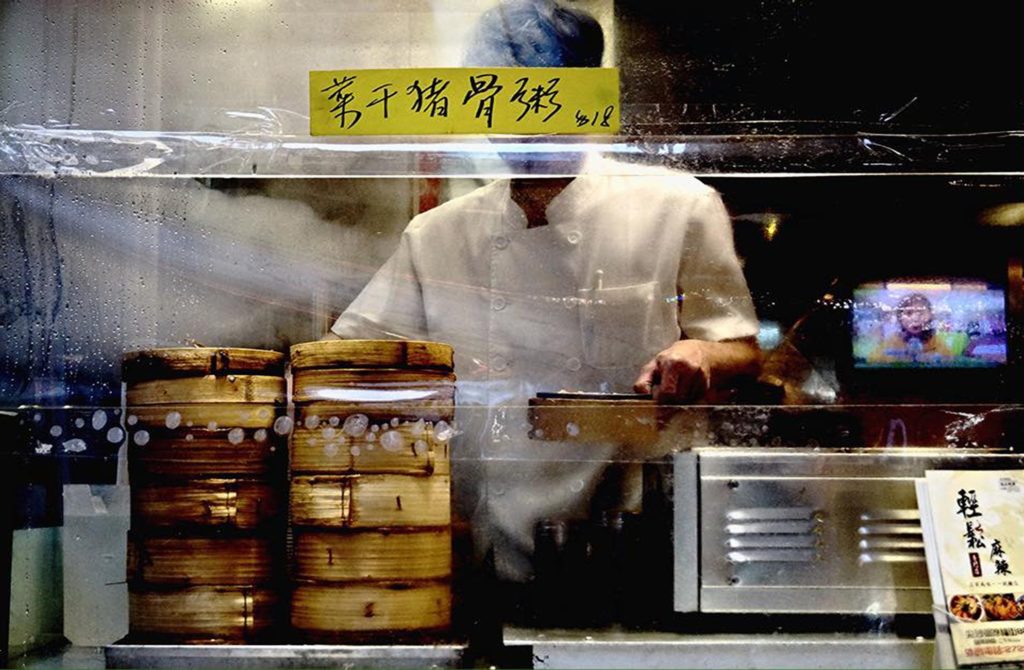
Terenia Puspita (TP): For myself, it was around 2014. Before I became aware of my identity as a female migrant domestic worker, I took photos to capture the wonders of nature. Sunsets, beaches, mountains – they all bring me relief. When I first arrived in Hong Kong, I struggled to connect with society here. I was having trouble with work. I didn’t have holidays, I was underpaid, I didn’t have my ID, I didn’t have my passport, I didn’t have my phone, my employer was difficult. I was disconnected from the world. But Hong Kong is a beautiful place and connecting with nature here healed my soul. When I went hiking with my friends, I saw my friend taking a picture and realised ‘Oh you can capture that moment, and revisit it later!’ Photography allowed me to preserve moments longer than what the eyes can see.
I took photos of objects—buildings, architecture, scenery—because I felt that humans were too cruel. I didn’t want to save them into my memory. Eventually, I came to accept that cruelty is part of the world. But there is still kindness. I found communities that help, support, and even save MDWs in different ways. That’s when I began taking pictures of humans.
CV: Is there a moment that made you realise that there is ‘still kindness’?
TP: 2014. The Umbrella Movement reminded me that there is kindness in society. People wanted to see change and were ready to make sacrifices to see it. Goodness and cruelty can coexist.
CV: You’re all part of Lensational, a social enterprise that empowers underrepresented women to share their stories through media training. How does your photography allow you to share stories, or even address issues that affect you—issues of migrant justice, women’s rights, and so on, particularly in the context of COVID-19? Recently, one of Hong Kong’s only reported local COVID-19 cases was a Filipino MDW. In response to this, the government implemented compulsory testing and vaccination policies for the city’s 370,000 MDWs. Terenia, you mentioned that you were just at one of the COVID-19 testing centres taking photos. What was that like?
TP: As a MDW myself, taking photos of other MDWs is a form of solidarity. There is an urgency I feel because of the racism and discrimination MDWs experience during the COVID-19 pandemic. I don’t think the government thinks about how we work from Monday to Saturday from 6am to sometimes 11pm or midnight, then use our one day off, spending more than 10 hours lining up under the sun to take a test. Some of us are fasting because it’s Ramadan. I cannot let something like that just pass. Photography has become my way of [both] urging the government to respond to issues of racial injustice, and expressing solidarity.
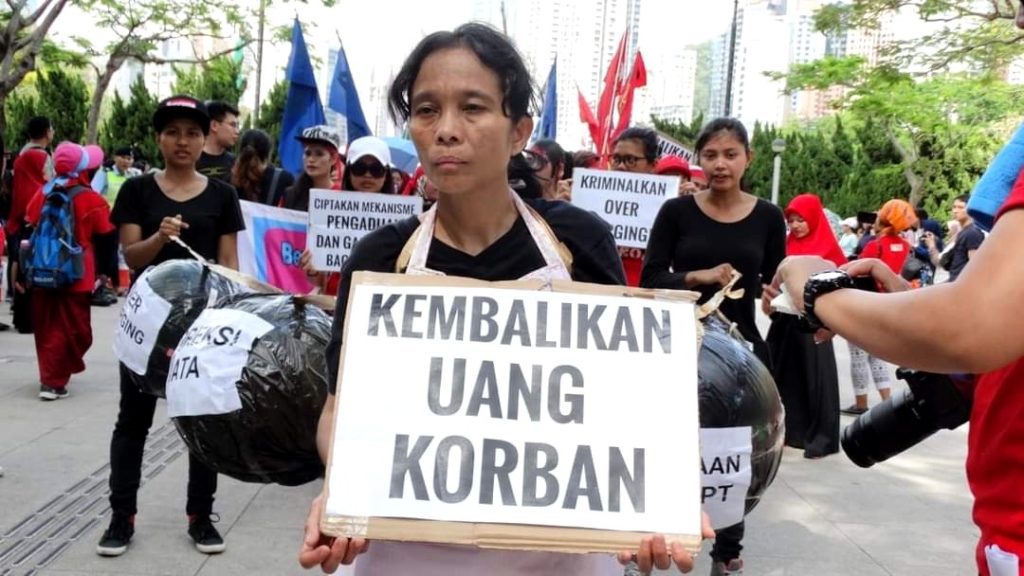
CV: And for you, Leeh Ann?
LAH: For me, photography enables us to show different issues that affect migrant workers. We all have different styles, and through that, we are able to show the different facets of a migrant worker’s life. When we hold the camera in our hands, it helps us break the stereotypes attached to us. ‘Oh, you’re a domestic helper? Why are you not on the streets, sitting with your friends on cardboard boxes?’ This image is often associated with ‘domestic worker’ and ‘day off.’
CV: It’s like your camera gives you a sense of agency. It allows you to reclaim your identity, and to break away from the image people have created in their heads of what a MDW should be. Khristel, do you resonate with this?
Khristel Mae Dacanay Alterado (KMDA): Hong Kong has become my second home. Despite the negative experiences, I want my photos to capture the positive aspects of life as a MDW. This is not to say that we should hide the negative. For me, it’s about the photographer’s intention. When I take photos, I do so with the intention of uplifting others. Back when I first started taking photos with my phone, my friends would be each other’s camera women and take fun OOTDs (Outfits of the Day). Until now, the aspect of joy in my photography remains. Lately, I find myself capturing relationships between people. I’m a COVID-19 survivor. After spending 19 days in the hospital, I realised I never felt isolated because of my employers, the hospital staff, the doctors, and my Lensational community. I never felt isolated because of the community around me. So now whenever I see people together, an old couple, a mother and a daughter, I have this desire to capture the love shared between them. My photography is centred on joy, desire, and love.
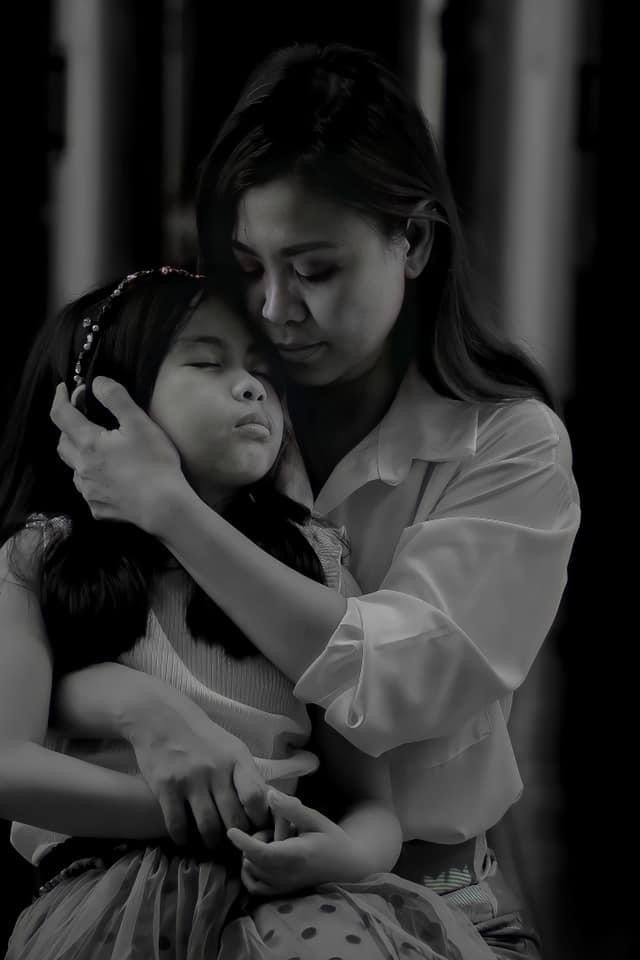
CV: Definitely. Capturing joy is just as important as capturing loss and pain. Joy, desire, and love are dimensions of resistance we don’t talk about enough.
LAH: On the topic of community, I’m reminded of when I was invited to be a guest speaker at a lecture at the Chinese University of Hong Kong with Professor Ju-chen Chen. I was asked to prepare questions for the students. One of the questions I asked was: ‘Do you think there are stereotypes against MDWs? If so, what can you do to help get rid of them?’ I was surprised with the answers. Some of them answered by asking questions about how they can help me, not as an individual, but our broader MDW community. I realised that the students also see the larger structural issues at play.
TP: Yes, many still deny that the mandatory testing notice for MDWs is racialised. Their justification is that we tend to children and the elderly, so we need to be tested. They don’t want to admit that this is an instance of racism. For me, what the mandatory testing notice made clear is the unity amongst MDWs because of the struggles we share—racial discrimination, labour exploitation, and so on.
CV: Recently your photos were featured at an exhibition entitled ‘We Create Home Kong’ at Book Punch. The title of the exhibition makes me question what it is to be a 香港人, a Hong Konger. How would you say the exhibition as a whole, and your individual photos in particular, help you navigate your identities as women and MDWs, or address the issues Terenia brought up?
LAH: When we were planning details of the exhibit at Book Punch, we made a conscious decision that it should feature photographers from both the Indonesian and Filipino communities. Our perspectives are different, but photography is our common denominator. Bringing together individuals from different backgrounds allows people to see different stories and issues that each of us face. For Khristel, it’s not just about MDWs, it’s about the different experiences of Filipinos here in Hong Kong. Terenia’s photos, on the other hand show that she was not just a spectator during the 2019 protests but was part of [them].
CV: Do you consider yourself Hong Kongers?
KMDA: Yes. Home is not just a physical, geographical place. It’s not just your home country—it can be people who love and care for you. It doesn’t matter where you are. There are a lot of people I met in Hong Kong whom I consider my chosen family. Hong Kong is home.
TP: For myself, on a spiritual level, I am a Hong Konger. When it comes down to documentation and citizenship, of course not. Racism is articulated in our citizenship status. Because of our documents, we will never be recognised as Hong Kongers. Some Hong Kongers will never recognise us as Hong Kongers. To them, we are just immigrants. Despite the cruelty I have experienced, there is still kindness. Many of them have shown me how to love myself, how to care for myself, and the importance of building community. So, if you’re asking me if I belong here: yes, of course I belong here. I am part of Hong Kong, and Hong Kong is part of where I belong. I know I won’t stay here forever, and that the journey will continue. But in the meanwhile, Hong Kong is my home.
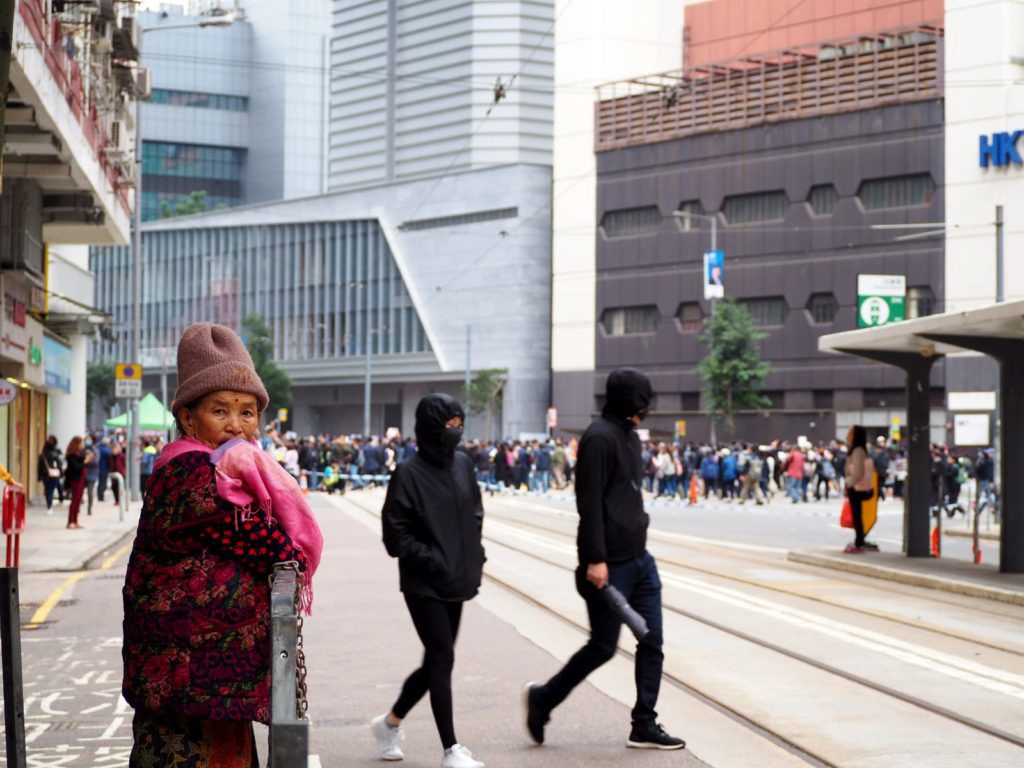
LAH: That brings us to the exhibition’s theme: through our photos we want to create Hong Kong. We want to show Hong Kong is our home, too.
CV: Indeed. At the end of the day, Home is where you choose it to be. One theme that struck me is Khristel’s comparison between Filipino permanent residents and MDWs. Can you share a little bit about those photos?
KMDA: Both my employers are Filipinos, like me. I wanted to highlight the differences between the experiences of Filipino MDWs and Filipinos who are Hong Kong permanent residents. Even though we’re Filipino, the numbers on our HKID point to the differences in our citizenship status. My employer is very supportive of my passion for photography. She’s actually the one in the photo. What touched me was when she said ‘Oh, sino pa ‘bang mag tutulungan?’ [Who else will help?] We’re the same. She came here as a singer, and I came here as a MDW. We both moved to Hong Kong to find work. Through my photos, I wanted to show people that despite being permanent residents who are better supported by the government, they also face struggles as Overseas Filipino Workers (OFW). We are different yet connected through similar struggles.
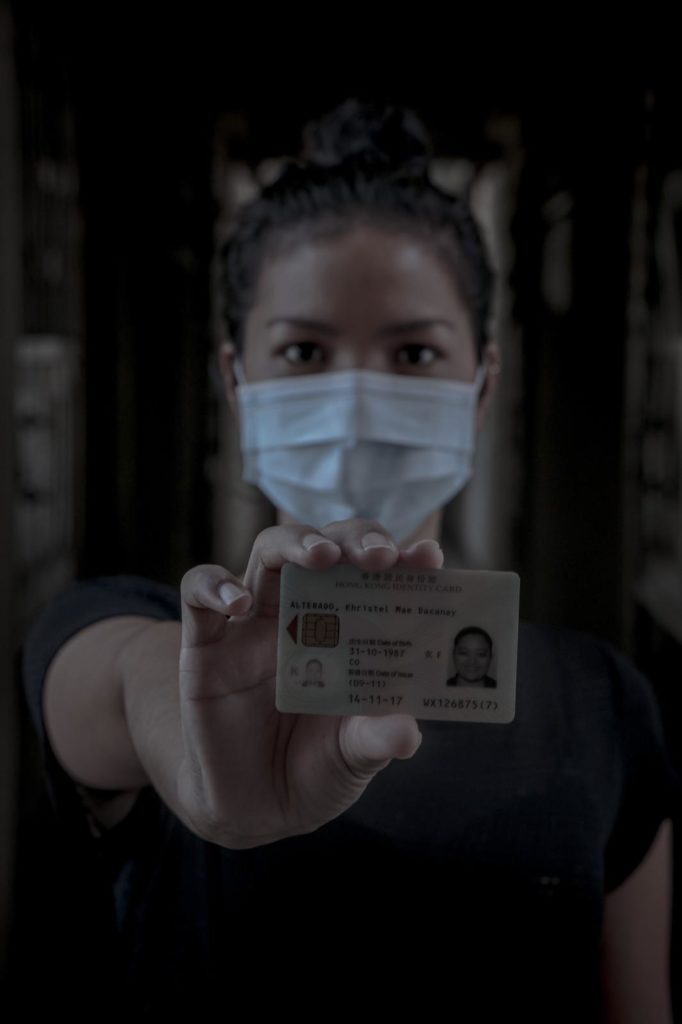
CV: It’s important to recognise the shared struggles as well as the difference and privilege, which you’ve captured in your photos. There is that common experience of leaving your roots, either in the Philippines or Indonesia, and creating new routes to places elsewhere, in your case Hong Kong. The act of leaving home, forging a new route for yourself—there’s a lot that happens in between. Yes, there’s pain and loss, but being able to provide for yourself and your family, that’s empowering, no?
TP: Yes. You become more independent when you are able to make decisions for yourself. You can find purpose when you find something worth fighting for. The photos I took are mostly of migrants and locals fighting for different issues. One photo I took captures migrants protesting for gender equality. Many women in Indonesia don’t have the privilege to choose who they are, what they want to become, or what they want because of societal expectations. In the photo, one MDW wears a mask usually worn by men in a Jaranan, one of the many traditional Javanese dances. Before COVID-19, they would perform these regularly at Victoria Park. Now due to social distancing, we stopped these performances.
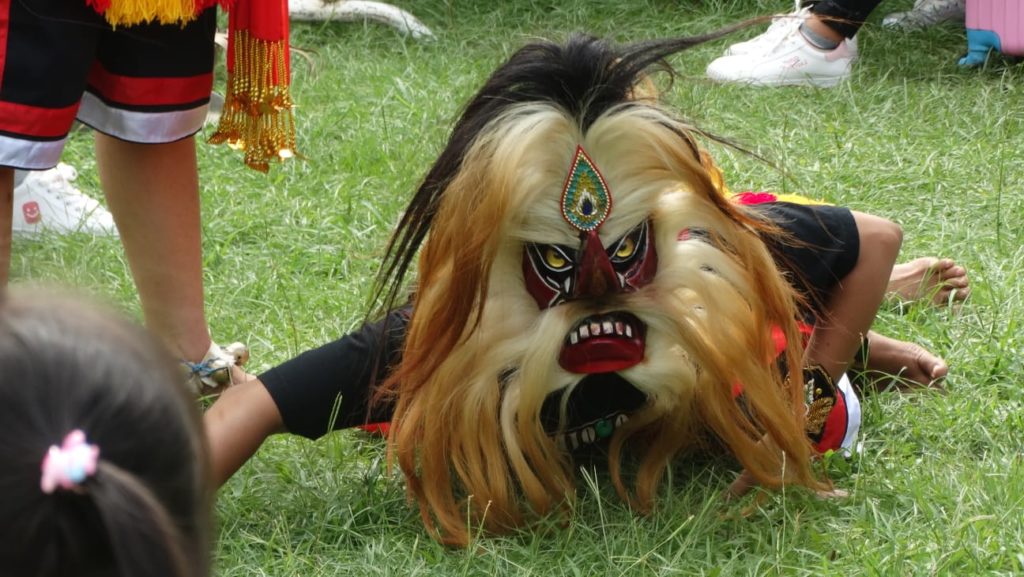
The masks represent different gods in Indonesian folklore and mythology, and [these characters] are usually portrayed by men. The fact that women are often excluded from these traditions is just one example of how there is no gender equality in society. So it makes me happy to see many Indonesian MDWs who are women participate in these performances. In capturing women doing things men usually do, the photograph becomes a form of protest. A protest against religion, tradition, and other things that exclude women. Another photo captures Hong Kongers protesting in 2019. Our struggles are what connect us across different boundaries. That is what I want to highlight through my photos. Whether a local or a migrant we share the same values—equality, democracy, and so on. Indonesia is a democracy, but only on paper. In Hong Kong, I see a similar struggle. Freedom comes at a cost.
CV: What you said about the shared struggles reminds me of what Angela Davis wrote in ‘Freedom is a Constant Struggle’ about the importance of recognising not only the ‘intersectionality of identities, but intersectionality of struggles’ (Davis, 2016: 144). Even though we’re in different parts of the world, if you recognise the interconnectedness between racism, sexism, capitalism, colonialism, heteropatriarchy, political oppression, and so on, you can see we are all connected. Leeh Ann, how do you think being a woman influences your photography?
LAH: Growing up in a patriarchal society, women are often silenced. But with photography, we are given a voice. What’s good about photography is that people can interpret photos however they want. We are able to address issues that affect us without offending patriarchy’s ego.

CV: I think you all agree that photography has allowed you to say things without saying them. It’s allowed you to break through boundaries and create connections people weren’t able to see before. In your experiences as photographers, how do you think photography has allowed you to resist capitalism, heteropatriarchy, oppression, exploitation?
LAH: Because of my photography, I am often labelled as an activist. Yes, of course I am an activist. The act of taking photos and my photos themselves go against the stereotypes associated with, na dinidikit sa mga [that are imposed on] domestic workers. It gives me a voice and the confidence to show everyone that I am not just a domestic worker. That I am more than just my job.
TP: For myself, photography heals. With photography, I notice things that many do not—the sadness in people’s eyes, the happiness in their laughter. It makes me realize many of us share the same struggles and in doing so has taught me to cope with and overcome loneliness. Photography also gives me power to stand up for myself, and hope that society will be better. Capitalism affects people differently, but as MDWs, we don’t have much of a choice. As women MDWs, our photography reveals to people the struggles we face, and urges them to reflect on how in many ways, we are not different.
KMDA: Photography saved me. It helped me cope with my mental health. It helped us gain respect. People no longer see us as just maids. People see us as more than that.
Notes:
[1] be/longing is a community arts-for-education lab that harnesses the transformative power of storytelling to cultivate and co-create cultures of inclusion for Hong Kong’s ethnically-diverse communities. Khristel and Leeh Ann facilitated our pilot Storytelling x Photography workshops in 2021. See https://belonginghk.wordpress.com/ for more information.
[2] To learn more about Lensational Hong Kong, visit their Facebook page at https://www.facebook.com/lensationalhk/ or the Lensational website at https://www.lensational.org/
REFERENCES
Carvalho, Raquel (2019), ‘Migrant Domestic Workers Prop up Hong Kong’s Economy, So Why Are They Excluded?’, South China Morning Post, 6 March 2019, https://www.scmp.com/week-asia/economics/article/2188754/migrant-domestic-workers-prop-hong-kongs-economy-so-why-are-they?module=inline&pgtype=article (last accessed 26 October 2021).
Cheng, Selina (2021), ‘Hong Kong domestic workers faced wave of sex attacks and physical abuse during pandemic ‘lockdown’, Hong Kong Free Press HKFP, 29 June 2021, https://hongkongfp.com/2021/06/29/hong-kong-domestic-workers-faced-wave-of-sex-attacks-and-physical-abuse-during-pandemic-lockdown/ (last accessed 1 November 2021).
Chu Man-kin, Ricky (2021), ‘More than Gratitude, Hong Kong’s Domestic Helpers Deserve Respect’, South China Morning Post, 16 June 2021, https://www.scmp.com/comment/opinion/article/3137306/more-gratitude-hong-kongs-foreign-domestic-workers-are-due-respect (last accessed 26 October 2021).
Davis, Angela Y. (2016), Freedom Is A Constant Struggle: Ferguson, Palestine, and The Foundations of a Movement, Chicago: Haymarket Books.
Leung, Hillary (2019), ‘Here’s How Much Domestic Workers Add to Hong Kong’s Economy’, Time, 6 March 2019, http://time.com/5543633/migrant-domestic-workers-hong-kong-economy/ (last accessed 28 October 2021).
Lin Sihan 藺思含 (2021), “外傭經濟・一|疫情下的外傭姐姐 撐起國家經濟生命線”, 香港, 2 August 2021, https://www.hk01.com/%E4%B8%96%E7%95%8C%E5%B0%88%E9%A1%8C/658362/%E5%A4%96%E5%82%AD%E7%B6%93%E6%BF%9F-%E4%B8%80-%E7%96%AB%E6%83%85%E4%B8%8B%E7%9A%84%E5%A4%96%E5%82%AD%E5%A7%90%E5%A7%90-%E6%92%90%E8%B5%B7%E5%9C%8B%E5%AE%B6%E7%B6%93%E6%BF%9F%E7%94%9F%E5%91%BD%E7%B7%9A (last accessed 26 October 2021).
Siu, Phila (2018), ‘Beaten Indonesian Domestic Worker Erwiana Sulistyaningsih Demands to Know Why Hong Kong Abuser Was Released from Jail Early’, South China Morning Post, 22 November 2018, https://www.scmp.com/news/hong-kong/law-and-crime/article/2174567/beaten-indonesian-domestic-worker-erwiana (last accessed 27 October 2021).
Tuck, Eve (2009), ‘Suspending damage: A letter to communities’, Harvard Educational Review, Vol. 79, No. 3, pp. 409-428.
Unknown (2019), ‘$12.6 Billion Windfall from Imported Maids’, Asia Times, 7 March 2019, https://www.asiatimes.com/2019/03/article/12-6-billion-windfall-from-imported-maids/ (last accessed 26 October 2021).
WHO SUPPORTS US
The team of MAI supporters and contributors is always expanding. We’re honoured to have a specialist collective of editors, whose enthusiasm & talent gave birth to MAI.
However, to turn our MAI dream into reality, we also relied on assistance from high-quality experts in web design, development and photography. Here we’d like to acknowledge their hard work and commitment to the feminist cause. Our feminist ‘thank you’ goes to:
Dots+Circles – a digital agency determined to make a difference, who’ve designed and built our MAI website. Their continuous support became a digital catalyst to our idealistic project.
Guy Martin – an award-winning and widely published British photographer who’s kindly agreed to share his images with our readers
Chandler Jernigan – a talented young American photographer whose portraits hugely enriched the visuals of MAI website
Matt Gillespie – a gifted professional British photographer who with no hesitation gave us permission to use some of his work
Julia Carbonell – an emerging Spanish photographer whose sharp outlook at contemporary women grasped our feminist attention
Ana Pedreira – a self-taught Portuguese photographer whose imagery from women protests beams with feminist aura
And other photographers whose images have been reproduced here: Cezanne Ali, Les Anderson, Mike Wilson, Annie Spratt, Cristian Newman, Peter Hershey
